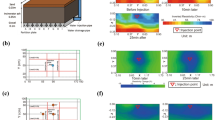Abstract
Over the last decade, waste disposal has become a particularly sensitive issue in Algeria. New legislation concerning landfill liner design has been adopted. Traditional methods of landfill liner characterization involve soil sampling and chemical analysis, which are costly, destructive and time-consuming. New techniques are currently being investigated that aim to provide nondestructive liner characterisation. This paper details technical aspects associated with electrical conductivity measurements within landfill liners and presents experimental work to show the direct application of electrical techniques to track ionic movement through a sand bentonite liner under chemically induced flow. Samples of sand bentonite were mixed and compacted with NaCl electrolytes at different concentrations. The electrical conductivities of compacted specimens were measured with a two-electrode cell. The effects of frequency and electrolyte concentration on the conductivity measurement were explored. The relationship between the soil electrical conductivity and the NaCl electrolyte concentration in interstitial pore fluid was determined. The conductivity measurements were used to quantify the pore fluid concentration and effective diffusion coefficient of sand bentonite liners. It is concluded here that the electrical conductivity of compacted specimens depends mainly on the salt concentration in the pore fluid, and that this approach could therefore be used to track ionic movement through liners during diffusion.





Similar content being viewed by others
References
Abu-Hassanein Z, Benson C, Blotz L (1996) Electrical resistivity of compacted clays. J Geotech Geoenv Eng 122(5):397–406
ASTM (1991) Annual book of ASTM standards. Soil and rocks; dimension stone; geosynthetics, Section 4: construction, vol 0408. American Society for Testing and Materials, Philadelphia, PA
Blewett J, McCarter WJ, Chrisp TM, Starrs G (2001) Monitoring sedimentation of a clay slurry. Geotechnique 51(8):723–728
Broderick GP, Daniel DE (1990) Stabilizing compacted clay against chemical attack. J Geotech Eng ASCE 116(10):1549–1567
Crank J (1975) The mathematics of diffusion, 2nd edn. Clarendon, Oxford
Daniel DE (1993) Geotechnical practice for waste disposal. Chapman and Hall, London
Dias CA (1972) Analytical model for a polarizable medium at radio and lower frequencies. J Geophys Res 77:4945–4956
McCarter WJ (1984) The electrical resistivity characteristics of compacted clay. Geotechnique 34(2):263–267
McCarter WJ, Desmazes P (1997) Soil characterisation using electrical measurements. Geotechnique 47(1):179–183
Mitchell JK, Arulanandan K (1968) Electrical dispersion in relation to soil structure. J Soil Mech Found Div ASCE 94:447–471
Mitchell JK, Bray JD, Mitchell RA (1995) Material interactions in solid waste landfills. Proceedings of a specialty geoenvironment 2000 conference. ASCE, New Orleans, LA, pp 568–590
Raistrick ID, Macdonald JR, Franceschetti DR (1987) In: Macdonald JR (ed) Impedance spectroscopy—emphasizing solid materials and systems. Wiley, New York
Rinaldi VA, Cuestas GA (2002) Ohmic conductivity of a compacted silty clay. J Geotech Geoenviron Eng 128:824–835
Rinaldi VA, Francisca FM (1999) Impedance analysis of soil dielectric dispersion (1 MHz–1 GHz). J Geotech Geoenviron Eng 125:111–121
Rowe RK, Quigley RM, Booker JR (1995) Clayey barrier systems for water diposal facilities. Chapman and Hall, London
Sen PN, Godee PA, Sibbit A (1988) Electrical conduction in clay bearing sandstones at low and high salinities. J Appl Phys 63(10):4832–4840
Shang JQ, Lo KY, Inculet II (1995) Polarization and conduction of clay–water electrolyte systems. J Geotech Eng 121(3):243–248
Smith-Rose RL (1933) The electrical properties of soils for alternating currents at radiofrequencies. Proc R Soc Lond 140:359–377
Smith-Rose RL (1935) The electrical properties of soils at frequencies up to 100 megacyclesper second; with a note on the resistivity of ground in the United Kingdom. Proc Phys Soc Lond 47:923–931
Stern RT, Shackelford CD (1998) Permeation of sand-processed clay mixtures with calcium chloride solutions. J Geotech Geoenviron Eng ASCE 124(3):231–241
Acknowledgments
This research was supported by the Algerian Research Project (code: J: 1301/04/50/05) from 01/01/2006 to 01/01/2008, entitled “Etude de transport et de l’infiltration des contaminants dans les sols fins: application aux sites de décharges”.
Author information
Authors and Affiliations
Corresponding author
Rights and permissions
About this article
Cite this article
Bezzar, A., Ghomari, F. Nondestructive test to track pollutant transport into landfill liners. Environ Geol 57, 285–290 (2009). https://doi.org/10.1007/s00254-008-1265-5
Received:
Accepted:
Published:
Issue Date:
DOI: https://doi.org/10.1007/s00254-008-1265-5




